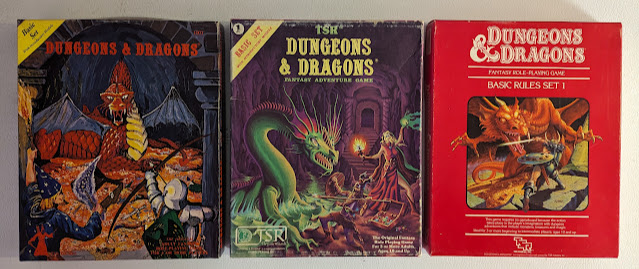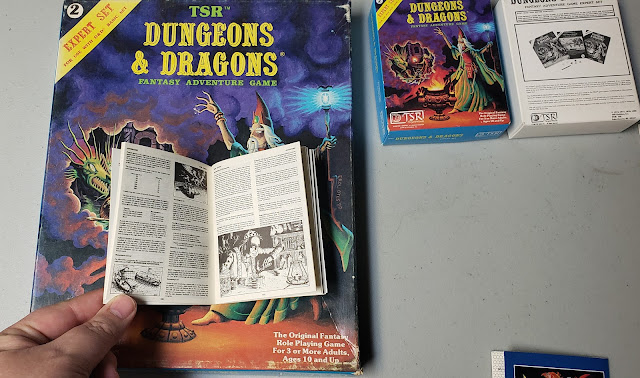Yesterday I talked about the Advanced Dungeons & Dragons game. Today I want to take a step back and talk about the Basic D&D game. Though there are several sets that can make the claim of being the "Basic Set."
Regardless of how many or for which edition they all share some things in common. The Basic set is usually a simpler or stripped-down version of the D&D game designed to introduce new players. They typically come in a boxed set and very often have the very first set of dice a player will own.
My own history with D&D begins with the Basic game.
Moldvay D&D BasicChristmas 1981 will forever go down in my memory as the one where everything changed. I was in Junior High and had been playing D&D for about two years, off and on. I had read the Monster Manual and I had a copy, badly xeroxed, of the Holmes Basic set.
Inside was finally my own book, not a copy of someone else's book. I had my own dice (finally!) and a complete adventure.
I devoured that book. Cover to cover. Every page was read and read over and over.
A lot of people talk about "the Red Box." My Red Box was magenta and had Erol Otis on the cover. For me this was the start of what became "my" D&D. Not someone else's game, but my own.
In 1981, I felt fairly proficient in D&D. But with Holmes D&D, I always felt like something was missing. I only learned later about the "Little Brown Books" and how "Basic" actually came about.
The Moldvay Basic set had almost everything I ever needed for a game. Plenty of classes and races. More monsters than I expected (it had dragons!!) and what then felt like tons of spells. I made dozens of characters, some that saw actual game play, but I didn't care, for me it was the joy of endless possibilities. And that was just in the first couple of dozen pages.
Everything I know about exploring a dungeon, checking for traps, carrying holy water and a 10' pole began here. I learned that ghouls can cause paralysis (unless you were an elf!) and that zombies always attacked last in the round. I learned that Thouls was a magical cross-breed between a hobgoblin troll and a ghoul. No, I still have no idea how they are made. I got to meet Morgan Ironwolf herself.
There was a sample adventure in the book, but I never really looked over. I don't think anyone did. It was called the Haunted Keep by the way. Though I very recently was reading that someone put it under the Keep in the famous adventure, Keep on the Borderlands.
This magenta-colored box with strange art on the cover also had other prizes. There inside was my first set of real D&D dice. No more raiding board games for six-siders, though I learned those dice were properly called "d6s," and my new ones were "polyhedral." I had a set of blue dice with a white crayon to color them in. They are not great dice, even then, I knew. But they were mine, and that is all that mattered.
I want to pause here a second and come back to that art. Let's look at the cover again. A woman casting a spell, a man with a spear. Fighting some sort of water dragon (that didn't even appear in the rules!). But look how awesome it is. Do you need to know anything else? No. They are fighting a dragon! That box is why so many gamers fell in love with the art of Erol Otis. Inside are some equally important names; Jeff Dee, James Roslof, David LaForce, and Bill Willingham. They gave this D&D a look that was different than AD&D. I love that art in AD&D, but in this book, that art was just so...timeless. It was D&D.
In that box was also the adventure The Keep on Borderlands. I don't think I need to go into detail there. We have all been to the keep. We have all taken that ride out along the road that would take us to the Caves of Chaos. Nevermind that all these creatures, who should by all rights be attacking each other, never really did anything to me. They were there, and they were "Chaotic," and we were "Lawful." That was all we needed to know back then.
 |
| What treasures in such a small box! |
The Moldvay Basic set was more than just an introductory set to D&D. It was an introduction to a hobby, a lifestyle. The rules were simply written and organized. They were not simple rules, and re-reading them today, I marvel that we all conquered this stuff at age 10-11. It may have only covered the first three levels of character growth, but they were a quality three.
I bought the Expert Set for my birthday in 1982. For the longest time, that was all I needed. Eventually, I moved on to AD&D. I discovered those Little Brown Books and even picked up my own real copy of Holmes Basic. I love those games, and I love playing them still, but they never quite had the same magic as that first time I opened up that box and saw what treasures were inside. I did not have to imagine how my characters felt when they discovered some long-lost treasure. I knew.
Today, I still go back to Tom Moldvay's classic Basic book. It is my yardstick for measuring any OSR game. Almost everything I need is right there, just waiting for me.
Basic D&D is a very popular topic for me on the old A to Z Blogging Challenge. Here are some other "Basic" posts I have done in past years.
- 2011 Basic D&D
- 2012 B is for Basic Clones (games that play like Basic D&D)
- 2016 A to Z of Adventure! B is for Basic Adventures
Other Basic Sets
It would be very remiss of me not to mention that there were other Basic sets as well.
Holmes Basic, also called the "Blue Book," was my start. Sort of. The rules I used back when I began were a hodge-podge of Holmes Basic and AD&D, particularly the Monster Manual. This was fine, really, since, at the time, 1979, these game lines were a lot closer to each other. I have talked about this in my "1979 Campaign" posts.
Edited by Dr. John Eric Holmes, this book took the original D&D books and re-edited them to a single cohesive whole, though limited to 3rd level, as a means to get people introduced to the D&D game. The Original Rules (see "O" day!) were an eclectic collection of rules that grew out of Gary Gygax's and Dave Arneson's playstyles. Debate continues on who did what, and I am not going to provide anything close to a definitive answer, but the game sold well but had a steep learning curve to others who were not part of that inner circle or came from War Games. The Holmes Edition attempted to fix that.
Mentzer Basic, or the BECMI (Basic, Expert, Companion, Master, Immortals) rules, was published after the Moldvay Basic, Cook/Marsh Expert sets. The rules between the B/X and BECMI rules are largely superficial (I will discuss this more), and the BECMI rules go past level 14 into the Companion rules (more on that tomorrow).
There is evidence that the Mentzer Basic set, also known as the "Red Box," was one of the best-selling editions of D&D ever, even outselling the flagship line of AD&D at times. It was also sold in more countries and more languages than any other version of D&D. If you recall Sunday's post, the D&D Basic line was in play for 22 years, covering the same time period as AD&D 1st and 2nd Edition rules. And it is still widely popular today.
 |
| Basic books from England, the USA, and Spain |
Is Basic D&D the Game for You?
Basic D&D (all three varieties) are all remarkably easy to pick up and play. Character creation is fast, and the play is super flexible. It is also one of the main systems I still love to write about and publish for.
Basic D&D has great online support regarding books from DriveThruRPG and other "Old School Renaissance" creators. But it is an older game. One of the oldest in fact. So, some things made perfectly good sense back then that would cause people to scratch their heads at the various design choices (Descending Armor Class? Level limits?), but that doesn't detract from the fun. Finding a Basic game or even people to play it with will be harder.
Any future version of D&D (or any RPG) needs to use Basic D&D as its model for introduction to the game.
Tomorrow, I will talk about a newer topic, Critical Role.


























































